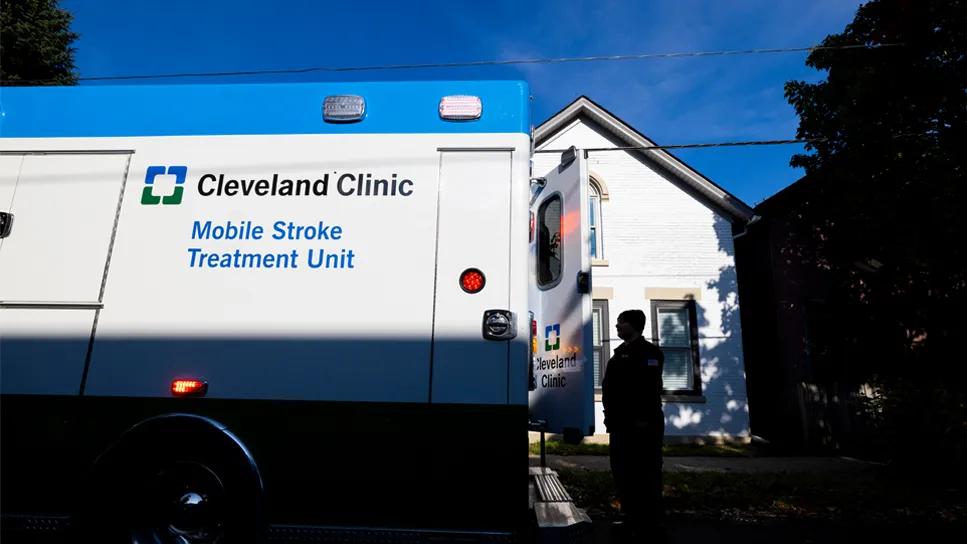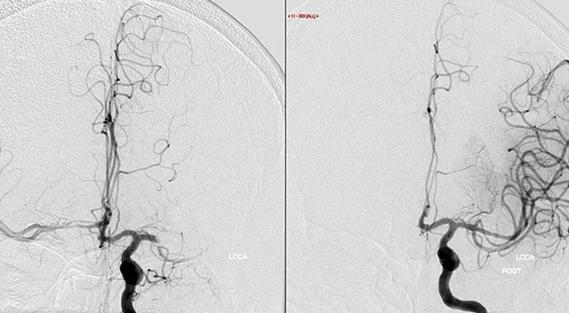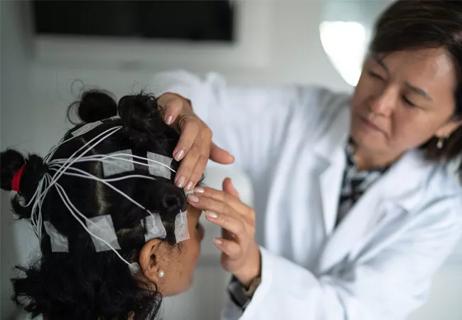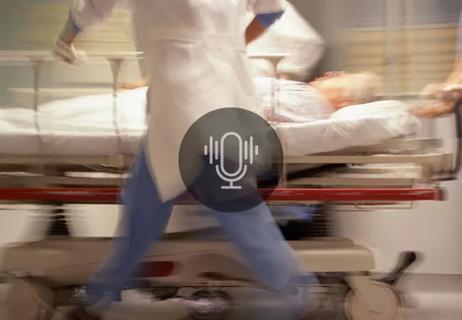Insights and what’s next for the first U.S. mobile stroke unit to treat patients

Ten years ago, in July 2014, Cleveland Clinic initially deployed its mobile stroke treatment unit (MSTU), making it the first such unit to deliver care in the United States.
Advertisement
Cleveland Clinic is a non-profit academic medical center. Advertising on our site helps support our mission. We do not endorse non-Cleveland Clinic products or services. Policy
Today the MSTU remains one of a relatively small number of such units in the U.S., and its impact on stroke care in Northeast Ohio is difficult to overstate. The MSTU now serves 13 municipalities in Northeast Ohio and had completed 12,761 dispatches and 2,644 patient transports as of the end of 2023, with 311 patients receiving intravenous (IV) thrombolytic therapy and 161 patients undergoing treatment for hemorrhagic stroke on the MSTU in the same period. Moreover, it has shaped and enhanced Cleveland Clinic’s overall stroke care program in ways that are less quantifiable but similarly significant.
“Over the past decade, mobile stroke care has become the crown jewel of our stroke program,” says M. Shazam Hussain, MD, Director of Cleveland Clinic’s Cerebrovascular Center and a vascular neurologist closely involved with the MSTU since its inception. “The MSTU has been a central component of our commitment to offering the best stroke care to patients no matter where they are. It has likewise played a key role in accelerating our testing and adoption of new technologies for stroke care, as it can be a uniquely good laboratory for assessing new management approaches in the prehospital space. It has changed the paradigm of how to think about caring for patients with stroke.”
The MSTU is a specially equipped and staffed ambulance tailored to the management of suspected stroke. The unit is integrated into the municipal 911 dispatch system and carries a critical care team consisting of a CT technologist, a critical care nurse, a paramedic and an emergency medical technician.
Advertisement
This team is connected with Cleveland Clinic stroke neurologists via two-way videoconferencing. Through this connection, the team works with stroke neurologists in real time to evaluate patients with suspected stroke using an advanced CT scanner that wirelessly transmits brain images and using point-of-care lab equipment to test blood samples. Under direction of the neurologists, the team can administer intravenous (IV) thrombolytic drugs if indicated or take other management steps while the MSTU is en route to the nearest appropriate stroke-capable hospital.
“The unit is essentially a primary stroke center on wheels,” Dr. Hussain says. “It’s always been predicated on the concept that time is brain, with the goal of starting to manage patients as soon as possible. It also enables faster and better triage by allowing triage to be done right there on the vehicle. This can be invaluable in cases identified as requiring mechanical thrombectomy, as patients can be taken directly to the closest thrombectomy-capable stroke center. This avoids the treatment delays that too often result from hospital transfers when it’s determined that mechanical thrombectomy is needed after traditional transport. That is critical for this patient population.”


Dr. Hussain notes that the MSTU’s launch in 2014 was a natural progression of Cleveland Clinic’s pioneering use of telestroke care, which began in 2011 and featured a dedicated service line with stroke neurologists on call 24/7. He credits that — and the institution’s openness to an MSTU back in 2014 — to Cleveland Clinic’s leadership at the time. “The concept of an MSTU was pretty ‘out there’ in those days,” he says.
Advertisement
Dr. Hussain explains that Peter Rasmussen, MD, who directed the Cerebrovascular Center at the time, introduced the idea to Cleveland Clinic after meeting a German physician who helped pioneer the world’s first MSTU in Europe. He and colleagues visited Germany to learn more, and before long they were moving forward with one of the first two U.S. mobile stroke programs. The Cleveland Clinic team built on the German model by introducing the two-way video connection to allow remote assessment by stroke neurologists, which hadn’t been done in the MSTU setting before.
The Cleveland Clinic mobile stroke experience soon brought additional milestones (see infographic below).
In 2015, Cleveland Clinic clinicians presented data from the first 100 patients evaluated on the MSTU for IV thrombolytic therapy, comparing them with controls brought to emergency departments (EDs) by traditional ambulance. They found significant reductions in time to CT completion and thrombolytic administration with MSTU care. The results were published in full in Neurology.
“We also compared our times to imaging and treatment on the MSTU with the corresponding times at some of the best stroke hospitals in the world, in Finland and Australia, and found that our times were considerably shorter,” Dr. Hussain says. “We rapidly showed that by treating patients in the field, you’ll clearly treat them faster than by usual transport to an ED.”

Soon after, in 2016, the team published the first study demonstrating the feasibility and reliability of including a vascular neurologist in MSTU care remotely, via telemedicine, for evaluation and thrombolytic treatment of acute stroke.
Advertisement
In early 2019 Cleveland Clinic presented some of the world’s first data showing that treatment of acute ischemic stroke on an MSTU resulted in improved functional outcomes relative to traditional ambulance transport to an ED. “This has since been echoed by two larger studies, the multicenter BEST-MSU trial and the German B_PROUD study,” Dr. Hussain notes. “It’s a validation of the underlying concept that faster evaluation and treatment with the MSTU translates to an outcome benefit for patients.”
In 2020, the Cleveland Clinic team published an early study demonstrating the economic superiority of MSTU care for appropriate patients with suspected stroke, relative to traditional ambulance transport, once an MSTU program reaches thresholds of certain variables such as number of cases.
Other milestones came in the realm of hemorrhagic stroke. In 2015, clinicians with Cleveland Clinic’s MSTU published the first-ever report of successful anticoagulation reversal in a prehospital setting. And in early 2024, they presented data showing that MSTU care results in shorter times to target blood pressure, CT completion and medication administration for patients with acute intracerebral hemorrhage (ICH) compared with conventional emergency transport. The study was the first direct comparison between the two models of care for patients with ICH.
“Our latest ICH data have helped focus new attention on how MSTUs can improve care for ICH patients, not just through anticoagulation reversal but also through rapid blood pressure control,” Dr. Hussain observes. “And in the wake of the ENRICH trial’s demonstration of functional improvement from surgical clot evacuation in ICH, MSTUs are positioned to play a key role in rapidly identifying candidates for that intervention and getting them to the operating room as quickly as possible.”
Advertisement
Finally, Cleveland Clinic achieved a couple of milestones in advancing mobile stroke treatment at the international level. It hosted the 2016 International Mobile Stroke Summit, where the idea of establishing the international PRE-hospital Stroke Treatment Organization (PRESTO) was formalized. In 2019, Cleveland Clinic was represented on PRESTO’s first board of directors, and Dr. Hussain is currently president of the group’s executive committee. “From the very beginnings of PRESTO, we have been champions of establishing mobile stroke units as an important new paradigm for stroke treatment around the world,” he says.
One major focus for PRESTO and Cleveland Clinic has been working with the Centers for Medicare & Medicaid Services (CMS) to establish reimbursement for MSTU care. In the U.S., care delivered on a mobile stroke unit generally is reimbursed at the same level as care on any ambulance or life support vehicle. That falls far short of the actual expenses of owning and operating an MSTU, as it doesn’t cover the cost of, say, CT scans or expensive thrombolytic medications when they are needed.
“In the U.S., there is a large bundle of mobile stroke care that’s generally not reimbursable because it takes place in the prehospital space,” Dr. Hussain says. “That is the rate-limiting factor for wider MSTU uptake. There are many centers that have not been able to make these units financially viable. In 2018, we succeeded in getting CMS to reimburse for telemedicine delivered on an MSTU. We’re now working with Congress to get legislation passed to enable reimbursement for mobile stroke unit care more broadly. If that occurs, the floodgates will open and these units will proliferate rapidly.”
He credits Cleveland Clinic’s big-picture thinking for its willingness to operate its MSTU for the past 10 years despite these reimbursement obstacles. “We’ve looked at the MSTU not just as a specific program but in terms of what it does for the overall organization,” he explains. “We see it as bringing patients into our system, where they are often getting other types of care in addition to their stroke care on the MSTU.”
In fact, support for the mobile stroke concept is only strengthening. In 2023, Cleveland Clinic acquired a second MSTU to serve as the primary unit in operation. The new state-of-the-art vehicle is now alternated with the initial vehicle to help extend the vehicles’ overall lifespans.
Dr. Hussain says his group’s ultimate goal would be a fleet of four MSTUs to optimally serve Cleveland Clinic’s footprint in Northeast Ohio, with three vehicles operational at any one time. “Data suggest that the ideal population to be served by a single mobile stroke unit is 500,000 to 600,000 lives,” he explains. “In our region, that would translate to about three operational vehicles.”
Beyond helping more patients, such expansion promises other benefits as well. “MSTUs serve as a beautiful laboratory for what we want to try to do for stroke in the prehospital space,” Dr. Hussain says. “These units provide a great opportunity to understand new technologies that might help identify potentially severe ischemic or hemorrhagic strokes and triage them better and more rapidly.”
He cites the example of an investigational helmet that uses EEG or ultrasound to assess patients for brain bleeding without need for a CT. “The MSTU is a great place to test a technology like that because you can get a CT scan at essentially the same time as you get the data from the helmet, which provides ideal circumstances for comparison,” he says. Other examples include various stroke wearable devices that are currently being explored, or even telemedicine-enabled remote assessment by a stroke neurologist without the presence of a CT scanner.
“If technologies like these are validated through studies on an MSTU, they can potentially be adopted for use on general ambulances to provide better stroke assessment even when a full-fledged MSTU is not available,” Dr. Hussain concludes. “This is why mobile stroke units represent a true paradigm change in stroke care. Not only are they helping the patients they transport, but they are enabling us to reshape the future of stroke care delivery in other settings as well.”
Advertisement

Increasing treatment options are extending the window for continued functional gains

Study links large artery atherosclerosis and delayed presentation to poorer treatment results

$3.2 million grant will fund use of calcium-based imaging to record neuronal activity in ischemia model

Findings from large cohort analysis can guide ongoing quality improvement initiatives

Research to test clinical efficacy and cost-effectiveness versus standard-of-care rehab

Times to target blood pressure, CT and medication administration shorter than with EMS transport

Many patients unnecessarily continue the medications for years

AHA scientific statement offers best practices to improve care for high-risk populations